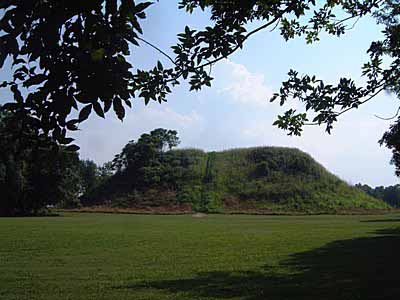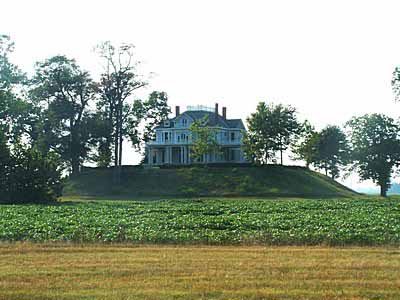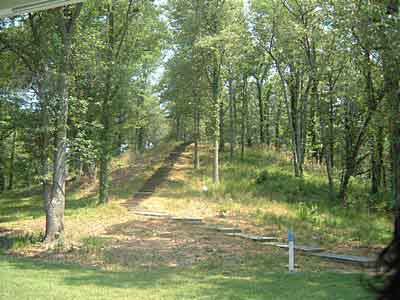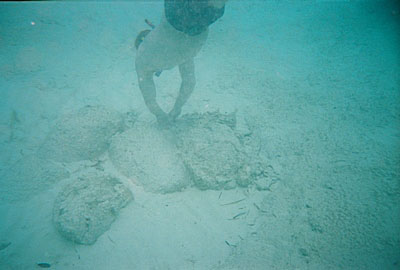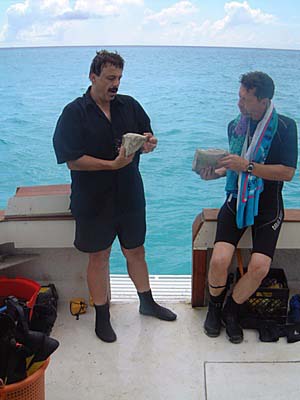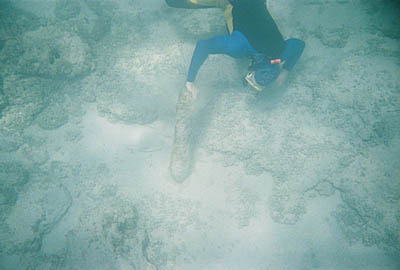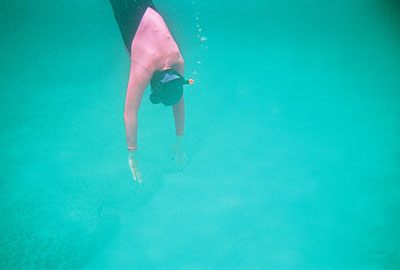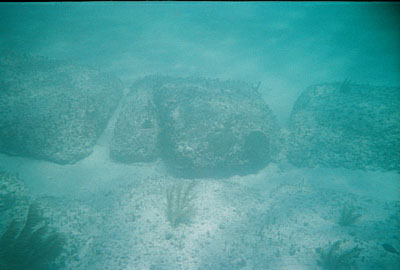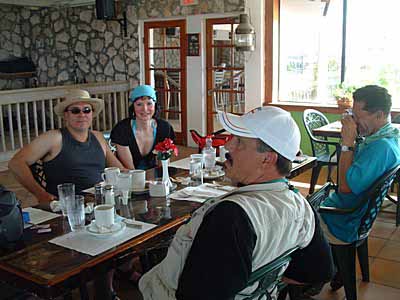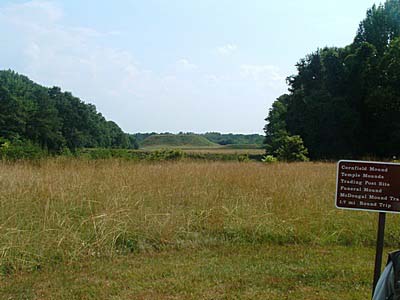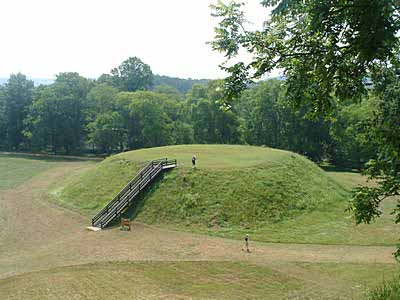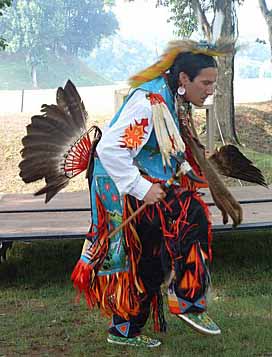![]()
![]()
THE
US MOUND TRIP 2006 AND THE SEARCH
FOR ATLANTIS IN THE BAHAMAS
A Diary Report by Andrew Collins
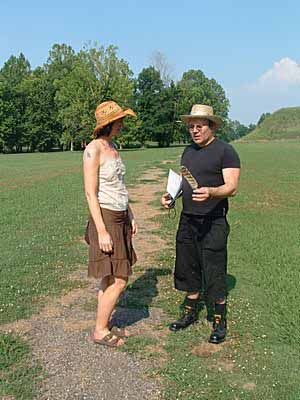
Sue and Andrew Collins at Winterville, Mississippi.
In 2004 my wife Sue and I were fortunate enough to be able to visit a number of the key mound sites of the Ohio Valley's Hopewell culture, and from this came some fascinating new insights into the sky religion and related death cult of the Native Americans' earliest ancestors, as is related in my new book THE CYGNUS MYSTERY and online. It was a journey that also brought us to, among other places, Point Pleasant, West Virginia, site of the Mothman sightings in 1966-7; Kelly-Hopkinsville, Kentucky, where in 1955 one of the most terrifying yet convincing UFO entity encounters took place, and also Memphis, the home of Elvis and the blues, all courtesy of our hosts Greg and Lora Little, both specialists in the field of ancient mysteries and Native American mound building cultures.
In 2006, we were invited back to the USA by Greg and Lora. This time we would explore and experience another round of mound sites from Mississippi right the way down to Louisiana and Florida in the southeast. There was even time to visit the Bahaman island of Bimini, which has been the focus of a search for clues to Plato's Atlantis ever since America's most famous psychic Edgar Cayce (1877-1945) predicted that a portion of that great landmass would one day rise off its coastline. Read my diary report, as I go in search of answers and inspiration visiting both Bimini and some of the south's most enigmatic ancient and sacred places.
THE DIARY BEGINS
Tuesday, 6 June.
Following a long and arduous flight from London to Memphis via Chicago
O Hare airport, we arrived at our final destination during the late
evening. The first thing Greg did on the short journey to the house
was to stop outside the gates of Graceland to make sure we realised
that we were back in the land of Elvis and the blues.
Our conversations
that night were on the Cygnus mystery, and its hypothesis that cosmic
rays from deep space have accelerated human evolution. This had led
only in the last day or so to the discovery that as far back as the
1970s world-renowned astronomer Carl Sagan wrote about cosmic rays from
neutron stars causing mutations in human DNA. It features in his book
THE COSMIC CONNECTION (1973), supplied from Greg's library, and resurfaces
again in THE DRAGONS OF EDEN (1977). Strange thing is that he does not
cite any references for such brilliant ideas, meaning that they were
most probably his own. Even though THE
CYGNUS MYSTERY was about to go to press, I managed to get in a paragraph
or two about this latest development.
We ended the first night talking about Greg and Lora's latest discoveries
in the Bahamas, particularly the clear identification of what might
well be jetties, piers and breakwaters off three islands - Bimini, Andros
and Anquilla - along with the discovery of what appear to be ancient
stone anchors found lying on some of these possible archaeological features.
It is fascinating stuff, and I could not wait to be back in Bimini,
which was where we would be in just under two week's time.
As I lay drifting off to sleep in a light dream state, I found myself floating through Bimini's shallow waters with a mosaic pathway of large stone blocks beneath me. Suddenly, I bumped into a fallen tree trunk, which knocked me clean out of the night vision. It made me consider whether there might be a tree or two down there in Bimini's blue waters. Maybe it is caught beneath a large stone block, meaning that it could be used to provide dating evidence for the underwater stone feature. It could even be that there was a fossilised forest out there somewhere, which might reveal further clues regarding the island's ancient maritime associations.
Wednesday, 7 June. Over breakfast I mentioned the brief glimpse of the fallen tree trunk on one of Bimini's underwater stone structures to Greg and Lora, who noted it with interest. Later on, Sue and I were taken to see 'The Da Vinci Code' film, which we watched in the movie theatre at the Peabody Centre in downtown Memphis. My initial feelings were that it is a brilliant film, even though there is no historical reality to the belief that Mary Magdalene spent her final years in France (see my book TWENTY-FIRST CENTURY GRAIL, 2004), or that Jesus ever bore her a child called Sarah. This is a French myth, based on a confusion between false medieval claims suggesting that the Magdalene reached French shores on a rudderless vessel, and the legend of Sarah of the Sea, the patron of the gypsies, who was also said to have arrived on a boat, in her case from Egypt.
Mary Magdalene
This having been said, the film's portrayal of Mary Magdalene as a consort
and confidante of Jesus, as well as its expression of the sacred feminine,
suppressed by the Catholic Church, is a wonder to behold. It even brought
tears to my eyes.
Good
also are the references to Mary's role in the much overlooked, and often
neglected, Gnostic Gospels, which are a clear embarrassment to the Catholic
Church, the reason why we are getting so many of these documentaries
denouncing 'The Da Vinci Code' book and film as merely badly researched
fiction. You watch them, their message is always the same - Dan Brown
is a poor researcher and he has got it wrong anyway. Just don't believe
what they say, for as I have said elsewhere, the book and film are very
important in that they help bring back into popular consciousness many
sacred values deliberately derided as heresy by the Early Church, including
the role played by women.
Great
too to see Isaac Newton's fabulous tomb in Westminster Abbey, and also
Rosslyn Chapel, which now presumably has the money to fix its perennial
leaking roof. As many of you will know, it is a place very dear to my
heart, having written extensively on the place over the years through
the inspired motivation of Rossyln's erstwhile guardian and unsung hero
Niven Sinclair.
He is
a descendent of the St Clair family (St Clere in Essex, see my book
THE KNIGHTS OF DANBURY (1985), all about their activities here). They
built Rosslyn as part of a proposed collegiate church in the mid fifteenth
century, and this rich edifice is a marvel of mystery in stone, reflecting
the inner symbols of Christianity, Judaism, Freemasonry and Paganism.
The
most amusing thing about the film was attempting to spot Sue and myself.
In one scene shot on a bus in the City of London, the main character
Robert Langdon (actor Tom Hanks) and his renegade French female agent
are upstairs using a palm-top to access the Internet. Behind them sit
the real life Lynn Picknett and Clive Prince, who asked and got a cameo
role after the director acknowledged that it was their book, THE TEMPLAR
REVELATION, that inspired the Leonardo da Vinci codes featured so heavily
in Dan Brown's original book.
When filming this part, Lynn and Clive said that, as they went past the Temple of Mithras on Queen Victoria Street, they saw Sue and I standing on the roadside. We were there exploring the site of London's former Temple of Isis for THE CYGNUS MYSTERY, and I do recall a red bus going along with a police car escort. Thus Sue and I wondered whether we are visible in the movie, down there on the street somewhere. I didn't see us, but we will examine the DVD frame by frame! (I have since been told that the cameras weren't rolling at the time. Boo-hoo.)
Da Vinci Code Film - The Verdict
Overall, the film was long, drawn out, sometimes slow, but in effect
and style, comprehensive and stunning, both visually and mentally. I
loved the reconstructions of historical events, such as Constantine
the Great and the Council of Nicea, the life of Mary Magdalene, and
the arrest of the Knights Templar on Friday, 13 October 1307. They are
episodes in history which have needed a visual airing in this manner
for a long time. Lots
of people criticise Dan Brown and his 'Da Vinci Code' bandwagon, but
I think we have to thank him for introducing the wider world to the
true mysteries of the Christian faith, surely not a bad thing.
Saturday,
10 June. Today Greg and Lora played host to a BBQ for members of
the local ARE group. The ARE (Association for Research and Enlightenment)
is the active wing of the Edgar Cayce Foundation, which preserves and
furthers the work of America's most well-known psychic. Two guests,
Brent Raynes and his wife Joan, both long time friends of Greg and Lora,
brought with them reproduction Peruvian ceramic whistling vessels. The
originals were made by the Chimu culture of Peru, although similar examples
have been found in neighbouring Ecuador, where they date back to the
late Machalilla/early Chorreran cultural horizons, which flourished
between approximately 1200 and 900 BC.
I was intrigued to learn that the sound they make, a high-pitched whistle, would seem to have been linked by the Chimu with the hummingbird, since a gold statue of a male figure, holding a beaker and wearing a ceremonial headdress, found at a Chimu site in north Peru, shows two of the birds dangling from his ears, like decorative ear rings - see 'The Hummingbird Clue' by Daniel K. Statnekov. He writes:
The attitude of the figure is ceremonial. Certainly, the manner in which he clasps the beaker conveys the posture of a man in ritual. Could this be a participant in an ancient rite of communion? Does the flask contain a concoction of Ayahausca or San Pedro cactus, two of the more efficacious hallucinogenics known to the Chimu? .... Consider the sound of the hummingbird as it flies or hovers overhead: a low pulsating flutter, as if a large night butterfly, drawn to the light, beats its powdered wings against the glass. The hummingbird's sound is unique in nature, but, interestingly, the Chimu knew how to reproduce it. Following a tradition that had existed for more than a thousand years, Chimu potters fashioned ingenious ceramic bottles that whistle when you blow into them, and when played in concert, create a sound that is most succinctly described as the low fluttering sound of a hummingbird in flight.
Moreover, when using the ceramic whistling vessels people have reported hearing a sound like a hummingbird's wings. All this I found interesting, since the bird most associated with Cygnus in Nascan tradition is the hummingbird. Some researchers have actually argued that the hummingbird among the giant drawings on the Nasca Plain is aligned to Cygnus, although this does not appear in THE CYGNUS MYSTERY as I was unable to confirm this fact from academic sources. This said, creation myths worldwide feature cosmic birds that let out a divine call which brings the universe into manifestation, and all are connected with the Cygnus constellation. I wondered if there was a link here between the sound of a hummingbird and the act of divine creation in Andean mythology.
Chimu Whistling Vessels
Brent - a well-known UFO writer, and Joan are custodians of these rare
Chimu whistling vessels, and they offered those assembled the chance
to use them during a boat trip out on the lake behind Greg and Lora's
home as sunset approached. The water's were still, other than the sound
of a flock of geese passing over, but as many of the party began blowing
gently into the vessels' spouts the atmosphere began to change. Everyone
seemed to be entering the spirit of the thing, and I for one closed
my eyes and began seeing strange imagery illuminated in a dark visionary
landscape.
I saw three pumas, or jaguars, forming a ring, nose to tail. They seemed
to be constantly revolving around and around to form a ring-like appearance.
I then saw an animal-human hybrid with an almost baby like face, which
bounded up to me on all fours. Although unidentifiable initially, I
quickly realised that the creature was a were-jaguar, a symbol of the
sky-world in Olmec art and mythology. I sensed the whistling vessel's
connections with Ecuador, and then watched as the curious hybrid creature
climbed a pathway of stars, which I identified as a symbolic representation
of the Milky Way. All the time the landscape was dark, but colourful,
like the contents of some traditional visionary painting.
After everyone had ceased blowing their whistling vessels, I was the
first to share my imagery with the assembled group. Immediately, others
all said they too had seen a revolving ring of energy, spinning or turning.
Brent saw a spinning ring of water, while Sue saw a wheel-like cross.
Even Greg, who rarely says what he sees in meditational situations,
reported seeing what he described as a swirling circle of 'nodules in
pockets'. When he opened his eyes, they were gone, but on closing them
again, they were back. This happened three times in all.(For more information
on the results of this experiment go to the Mysterious America site,
and for an interview with me conducted by Brent Raynes that day, click
here)
During conversations afterwards, Brent and Joan revealed that Native
Americans sometimes used eagle flutes to create the sound of the eagle,
a bird of creation in sacred myth. This struck me as interesting, for
swan flutes have been found in Europe which are dated to around 35,000
years ago. I mention them in THE
CYGNUS MYSTERY, since the bird's call is connected with both creation
and death in some parts of Asia. I wondered whether swan flutes, like
those of the eagle, might just have been tuned to the sound made by
the bird itself.
Another conversation with Joan, who is part Cherokee Indian, revealed
the symbolic meanings of each of the four cardinal directions in tribal
lore. East is illumination and clarity. South is innocence and childhood.
West is backwards, introspection and death, while the north is connected
with the 'white haired' ones, i.e. the elders, as well as 'long time
deep knowledge'. Since the north in the Northern Hemisphere was seen
as the direction of cosmic life and death, and also the location of
heaven or the sky-world, I suspected that the Cherokee cosmological
world was ancient indeed.
For many Native American peoples the sky-world in the north, often marked
by the stars of Cygnus, was accessed via the point that the Milky Way
stood perpendicular on the horizon around the time of the summer solstice
(for more, keep reading).
Sunday, 11 June.
Greg and Lora, Sue and I left in a large SUV bound for some of the more
overlooked mound sites of the deep south. In Mississippi, among the
levies, bayous and oxbow lakes of that great river, we stopped momentarily
at the junction of US Highway 61 and US Highway 49 near Clarksdale,
for it was here supposedly that legendary blues guitarist Robert Johnson
(1911-1938) sold his soul to the devil, so that he might become the
great musician that he did. It is a story that has inspired many songs,
including Charlie Daniels' 'The Devil went down to Georgia', and the
track 'Crossroads' by Eric Clapton's band Cream.
Beyond the constant drone of the cars and vehicles passing on the nearby
highways is a sleepy cemetery containing a small Native American mound
topped with a tree. Such places may have been used as spirit places
by followers of hoodoo (mainland American voodoo), like that found most
obviously in New Orleans. The god (lwa) named Papa Legba is guardian
of the crossroads. He is invoked in order to quite literally open the
way on to the path of fate and destiny. So instead of it being the devil
that Robert Johnson sold his soul to, it was more likely Papa Legba
that he called up and spoke to, for there is every reason to assume
that Johnson was at least familiar with hoodoo. The lyrics of some of
his songs are seen as well beyond his simple southern upbringing, dealing
with subjects that only an initiate might readily know about. It was
an interesting place to visit, whatever the answer.
A long journey in the blazing hot sun, the first of many over the next two weeks, brought us finally to a mound site called Winterville Mounds State Park Mounds, near Greenville, Mississippi.
|
It was once a thriving Native American village and trading centre - one of the largest belonging to the Mississippi Valley culture (the river is only a short distance away). They were the predecessors of the Choctaw and Chickasaw tribes, who inhabited the same general area at the time of the discovery of the Americas. The mound site remains one of the largest and best preserved of its type in the south. As we walked around in the intense heat we saw only one large flat-topped ceremonial earthwork called Temple Mound, thought to have been constructed as late as AD 1200. I sat at its base and attempted to attune to the site. I try not to allow my head to be filled with intellectual facts about a place before getting the chance to interact with a site on an intuitive level; that can come afterwards. |
Temple Mound at Winterville, Mississippi. |
|
Andrew Collins at the base of Winterville's Temple Mound |
I
tried to concentrate, but it was impossible due to too many interruptions.
Frustrated, I then felt the need to go across to a clump of trees
positioned on the mound's main axis line, around 200 yards away.
Reaching the spot, and being consciously aware of poison ivy or
even snakes in the grass, I hesitantly lent across and touched a
suitable tree. Almost instantly, there was a localised wind squall,
which I always take as a sign that some aspect of the site is awakening,
or aware of my presence. I sensed the presence, not fifteen feet away, of a Native American male, with a headband bearing a few feathers. He showed me the image of a flat metal figurine (shaped like a ginger bread man) with a head surrounded by a circle of zigzagging lines. I sensed it was some kind of localised sun-god, and strived to learn its name. I heard only the word 'Chez-en', whatever that means (I have since seen a couple of images online of similar Native American sun-gods). |
The Gift of a
Feather
The Native American then reached out and gave me a long feather, which
I guessed was that of a sacred eagle. He had offered this to me in exchange
for the small feather I had myself left as a gift at the base of the
mound, something which only then did I remember doing. I felt honoured,
as the scene faded from my mind.
Sue and Lora then came across to where I was, and I related what had
just happened. Sue said that she had felt strongly the presence of many
people, coming here from many locations, either exchanging items or
offering up gifts in celebration. When the wind squall had occurred,
she had picked up a distinctive name, which just happened to be the
nickname used by Lora's father, who had only recently passed away.
Sue and Lora then walked off as I took more photos of Temple Mound.
It was then that I sensed I should go back to the clump of trees, since
there was something there for me to find, a real gift - something that
would fulfil the words of the Native American I had glimpsed in mind.
Most obviously, I felt it would be a suitable bird feather. So I stood
once more by the tree and looked around. There was nothing here, and
so I realized I should perhaps go to where the figure had stood. Here,
too, the ground revealed nothing, but then my eye caught sight of a
butterfly alighting from a nearby shrub, and on reaching here I saw
on the exposed ground a large brown feather with black stripes. Somehow
I had known it was there, and that I would find it. It was a strange
and somewhat emotive realisation, which overcame me in a manner I am
not used to myself (I found no other feathers on the whole of the rest
of our trip, and I was looking).
|
The owl feather found at Winterville.
|
House on a mound located off US highway 16, close to the towns of Grace and Anguilla. |
Back in the SUV,
Greg looked at the feather and said that it was probably from an owl,
and indeed this seems to be correct. There is no way I could ever have
found and taken away an eagle feather, since in US law it is illegal
for non-Native Americans to handle them. So an owl feather was a suitable
replacement, especially as I discovered that in Native American lore
the gift of an owl's feather still viewed as a very potent 'token',
given when a Native American warrior goes on a quest to find 'medicine',
or magical power.
The alignment of the site through Temple Mound I estimated to be 31 degrees east of north, the importance of which still eludes me. (NOTE: quoted azimuths should be used as indications only. They have been corrected to true north.)
We moved on, passing various privately owned mound sites, with the most spectacular being a flat topped mound on which is an Amityville Horror-style house. It is located off US Highway 16, towards Highway 61, between the towns of Grace and Anguilla.
Monday, 12 June. I had gone to bed the previous night with the owl feather found at Winterville by my bed side. I hoped it might inspire a suitable astral dream, or two. Yet during the night all that happened of note was me being given a date - November 3rd 1951, which I felt compelled to write down. Sue suggested it might be Greg's date of birth, since we knew he was a Scorpio, and so over breakfast I asked him what year he was born. It was not 1951, but 1949. However, the month and day were indeed his birthday, meaning that he would have been two on November 3rd 1951. It was a fact that perplexed all of us, as we continued our journey onwards to what I hoped would be one of the highlights of the trip - Poverty Point, Louisiana, a famous and very ancient mound site of great importance to archaeology.
|
Constructed
as early as 1750 BC, the enormous earthen complex consists of
a series of earthen terraces, created to form a half octagon shape,
like a raised amphitheatre open towards the east. Immediately
behind the half octagon is an enormous effigy mound 640 feet across
from tip to tip. Known simply as Mound A, it forms part of a ritual
landscape that began, archaeologists have now determined, c.3500
BC with the construction of Jackson Hill Mound, just south of
Poverty Point. Since it conforms to an alignment of mounds that
includes Mound A and Mound B, located on the north side of the
Poverty point site, there is every chance that Poverty Point goes
back to this earlier age, which had previously only been associated
with the so-called Watson Brake culture, named after an excavated
mound site in northeast Louisiana. As much as I wanted to first sample the whole site on an intuitive level to see if it would speak to me, this became impossible after we were given a comprehensive introduction to the site by the site curator, historian and conservationist Dennis xx. |
Mound A at Poverty Point. |
On the trolley vehicle waiting to show us around the place, he produced a massive aerial reconstruction of Poverty Point, and proceeded to speak of the prehistoric township's layout and design. Afterwards, he drove us out first to see the terraces, before moving on to Mound B, and finally taking us to the foot of Mound A, which we ascended in the scorching heat.
Poverty Point's Mound A
Often Mound A is identified as an enormous bird effigy, due to the discovery
at Poverty Point of a number of stone and terracotta bird reliefs and
figurines. This was an identification I was unable to fully understand,
for although I could see the tips of its 'wings', which gave it an overall
width, there was certainly no head, which should have been placed beyond
its western face. Since Mound A's ascent was from the east, the direction
of the focus of the terraces, it seemed to me to have a roughly east-west
alignment. From its apex I measured a western orientation of 263 degrees,
an eastern axis line of 77.5 degrees, with the two 'wings' sloping away
at approximately 166 and 347 degrees respectively.
After Dennis had introduced us to Mound A, Greg and Lora departed with
him back down to ground level, as Sue descended also to meditate on
a convenient rest bench lower down on the 'wing'. This left me alone
on the summit to concentrate my efforts on attuning to the site. I sat
down on the wooden observational platform, faced east, and opened up
my mind to whatever might be there. I found myself repeating an unknown
chant of 'Ah-quee-nah-wah', and with it came a sense of passage associated
with a people coming from the west, modern Texas or further a field.
I saw a high cave overlooking the east, and an Indian elder, an old
man, marking the symbol of a bird on the southern wall.
Moving down to the bench on the mound's 'wing', where Sue had conducted
her own meditation, I closed my eyes once more and felt I should visualize
myself receiving fresh water from a large earthenware jug, which enlivened
me. There was then a sense of struggling up hill, like a sperm moving
ever nearer towards an unfertilised egg. This then became a serpent
on the Milky Way, which flowed up into the northern skies, where the
cosmic egg was to be found. I found myself visualising Ohio's Serpent
Mound, which I had visited two years previously, and wondered now whether
Mound A and Poverty Point might in fact align to Draco, the dragon.
If so, then the cosmic egg was something else, in my opinion perhaps
Cygnus, which borders Draco to the west.
Cygnus and Draco
A connection exists between these two key constellations of the northern
heavens, and this is expressed no better than in a Greek creation myth.
It speaks of the Great Mother Eurynome materialising from the formless
abyss that existed before time. Her movements thereafter produced a
powerful wind (a stellar wind?), which she was able to mould into the
form of a serpent (Draco?) that immediately began to lust after her.
Finally, she submitted to its advances, and on becoming pregnant Eurynome
transformed herself into a dove (Cygnus?) and brooded over the primeval
waters until the moment she gave birth to the cosmic egg. This the serpent
took from her, and protected within its coils until eventually the egg
hatched. From this came all that exists in the universe.
|
Andrew Collins puts his thoughts on camera as Greg Little looks on at Poverty Point. |
Only
after returning down to ground level and catching up with Sue, Greg
and Lora did I discover something very amazing indeed. Dennis had
revealed that new work on the archaeoastronomical alignments at
Poverty point by a man named Norm Davies had revealed that the site
is orientated northwards towards Draco. Certain mounds also acted
as entrance points to the Milky Way, via Gemini or Sagittarius/Scorpio.
These zodiacal constellations mark the two points on the Milky Way
where the ecliptic, the path of the sun, crosses, meaning that at
times such as the summer solstice the Milky Way can be seen rising
vertically up into the night sky from the position on the horizon
of one of these constellations). I have no further information on
these findings, and look forward to the publication in due course
of Davies' work on Poverty Point. I was never convinced that Mound A was a bird effigy. |
Moreover, in my absence Dennis informed Sue, Greg and Lora that each year small turtles climb the mound to lay their eggs near the summit. Once they hatch it is usual to see dozens if not hundreds of baby turtles crawling around, before the inevitable journey down the mound towards their new habitat. Surely, this cyclic process has been going on for hundreds if not thousands of years, and if so then it must have formed into the religious beliefs of the Native American peoples who lived at Poverty Point. Maybe, as Sue offered, Mound A is not a bird mound after all, but a turtle mound. Turtles, as I knew, were important in certain Native American traditions since one was said to have surfaced on the primordial waters at the beginning of time to form the first land.
Emerald Mound
From Poverty Point the journey took us on to Emerald Mound, Mississippi,
a gigantic mound site consisting of an enormous truncated pyramid form
that faces another much smaller mound across a huge elevated earthen
platform the size of a football field (British football that is). Such
sites dwarf places like Silbury Hill in England, Europe's largest manmade
mound.
Standing on the top of the large mound, I attempted to determine its
axis line in the blazing hot sun, the hottest I have ever experienced
in my life (it was over 100 degrees Fahrenheit). The orientation found
to be 95-96 degrees east of north, meaning that the elevated plaza is
aligned just south of east-west.
| It
was too hot to meditate on the mound itself, and so I descended
to the base of the giant earthen plateau. Here, beneath the shade
of some trees, I attempted to attune. I quickly sensed that the
site might once have been sacred, or important, to a thunder god,
or sky-god, like a Native American equivalent to the Norse god Thor.
I then saw myself on top of the elevated plaza as it might have
been in the past. Here were a line of wooden huts (influenced no
doubt by a pictorial representation of the site as it used to be
on a notice board outside the entrance gate). I found my mind entering
one of these structures, where an elderly Indian attempted to convey
to me the name of the deity. It sounded like 'tom-al', which I wrote
down. Once back in the UK, I discovered that Emerald Mound was built and occupied between 1250 and 1600 AD by the Natchez Indians. |
A large flat-topped mound at Emerald Mound, Mississippi. |
They venerated a 'creator god' named Thoume Kene Kimte Cacounche, whose creations were, in order, 'men, tobacco, and women'. He chose Natchez (the name of the area) as their first abode, which became the centre of all civil and religious affairs for the tribe. The first part of the god's name 'Thoume' - presumably pronouned 'tom-me', 'tom-mâ' or 'thom-mâ' - I deem too close to 'tom-al' for this all to be mere coincidence. There is no mention of him being a thunder god, or sky-god, however.
Tuesday, 13 June.
We travelled on from Mississippi to Florida, a 13-hour drive. There
were interesting talks in the car about the influence of cosmic rays
on the human psyche, and whether they might have been seen from a Christian
theological viewpoint as the 'holy spirit; and 'of God', while all matter
and physical existence was considered of the devil. If so, then it might
make sense of the whole idea of duality, in that the Gnostics believed
the physical world to be of Satan, and only the divine spark locked
inside us all was of God, this being released at the time of death.
It made sense since the earliest artistic representations of the Cross
of Crucifixion, the Christian symbol of death and redemption, have direct
links with Cygnus via the Greek mystery god Orpheus.
Finally, we arrived during the late evening at north Florida's Lake
City, which had just been whipped by the tail end of Alberto, the first
tropical storm of the season. An upturned palm tree lay across the path
outside the hotel, and the night air was still electric from the close
passage of the tropical storm. In the business room, I found an email
waiting for me from Aden and Marjorie Meinel of the Meinel Institute
of Las Vegas, saying that they were now 'seriously interested' in Cygnus
X-3. This is the galaxy's first suspected blazar, with a cosmic gun
barrel aimed straight at the Earth. I am championing it as the source
of the cosmic rays that I believe accelerated human evolution. It made
me feel jubilant and vindicated in my findings.
Wednesday, 14 June. The first Native American site we visited in Florida was the Madira Bickel Mound. It consisted of a series of earthen structures built in a secluded area close to Tampa Bay. Many of the mounds are either on private land or they have been destroyed, but one remaining example sitting inside a cloak of trees can still be ascended.
Lizards were everywhere - on the wooden fences, on trees or scurrying across the ground. I realised that those who had decided to live in such an isolated area would have been very much connected with water and the sea, why perhaps the only sense I had of them was the possible use of string ray spines, which were important to the Maya of Central America. Maybe the people here venerated the sting ray. As Sue said, there was a definite sense of people keeping themselves to themselves, as if keeping away from any possible trouble.
Sting Ray Spines and the Miami Circle
On my return to the UK, I found that sting ray spines had indeed been
used as tools by the earliest south-west Floridians, the ancestors of
the Tequesta, who inhabited the area around Miami before the town was
built. This included those responsible for the enigmatic Miami Circle
at Brickell Point, Miami, discovered during rescue operations by archaeologists
in August 1998(for more information on the use of sting ray spines download
the following article at http://www.flheritage.com/archaeology/projects/miamicircle/More/TequestaStudy.pdf
This unique monument,
some 1,700 to 2,000 years old, was found to consist of a ring of 24
postholes chiseled out of the limestone bedrock, with other lesser examples
outside the main circle. Excavations produced a ceremonial shark burial,
along with pottery shards, stone axe heads, and other artifacts.
Archaeologists had been called in as the site was about to be redeveloped
into a car park for a $126 million high-rise luxury condo complex being
built at Brickell Point, where the Miami River joins Biscayne Bay, close
to downtown Miami. Following a massive public campaign by protestors,
the site was saved, only for it to be buried beneath a newly-created
park, where it remains to this day.
Ortona Indian Mound Park
From the Madira Bickel Mounds we moved on to the Ortona Indian Mound
Park, just east of La Belle on the Caloosahatchee River in western Florida.
Apparently, the earliest Floridians entered the area and began building
mounds in c.500 B.C, although their peak of activity was AD 200-1000.
There is every indication that they hung on locally till around 1700,
and were superseded by members of the ever-resilient Seminole tribe,
who even sailed across to the Bahamas and established isolated communities
here.
Even though the earliest Floridians are mostly faceless and nameless,
here at Ortona they left as a legacy dozens of narrow canals, wide enough
for two canoes to pass. They criss-cross their way through the swamps
and everglades like modern irrigation channels.
We spotted the canals,
which stood out in the barren local landscape that seemed to reflect
a sudden shift of atmosphere on our journey. Firstly, we noticed a large
dead bird on the road side, which we initially took to be a hawk, yet
which actually turned out to be a turkey vulture (see below). The mound
site itself was uncharacteristically overgrown, and there was evidence
everywhere of ground disturbance by the feet of large, heavy animals.
I said it was probably a boar of some kind, but Sue started feeling
edgy, suggesting that it was alligators, which almost certainly inhabited
the lake nearby.
Apprehensively, we
skirted around the outside of the lake looking for a central mound,
with gators now firmly on our minds (there had been two reported attacks
in Florida already that year). Greg went to the water's edge and I followed,
at which I noticed a cactus plant. One of its oval lobes had broken
free, and stupidly I went to pick it up. I suddenly found my fingers
full of tiny needles. They were so small that they would need to be
removed very carefully indeed. Any excess movement would only push them
in more deeply, and so we made the decision to go straight back to the
car immediately.
A black cat came
out of nowhere and greeted us as Lora used tweezers to remove the dozens
of tiny needles. We left shortly afterwards, and stopped on the road
to look at the carcass of the turkey vulture. Lora took pictures but
nothing more, as it is illegal to take any remains from road kill. Just
as we got back across the road, a black bird on a post seemed almost
to be chatting to us, an odd fact we all noted, and just then a local
sheriff drove past, something that we would not have wanted to have
happened just minutes beforehand.
The whole experience left us slightly unnerved. Maybe, as Sue suggested, we had been picking up on the original inhabitants' constant struggle for survival in a very hostile environment indeed.
|
Sunday,
18 June. Following four days in south Florida, we travelled
out to Tarpon Springs where a local man had reported the discovery
of 'stone anchors', which he claimed were the same as those found
in association with the underwater stone features present in the
Bahamas. Without finding him, we sought more information from
the local historical museum, and were not impressed by what we
heard or saw in newspaper cuttings. So we came away from there,
quickly; well, after first enjoying a meal and some Guinness in
an Irish bar there. That afternoon we drove to South Beach, Miami, and here I led people to the British-run Clevelander Bar where they serve the best Rum Runners in the world. This pilgrimage complete, the four of us inspected a breakwater beyond South Pointe Park, at the southern tip of South Beach. |
Andrew and Sue order rum
runners
|
|
A
drilled quarry stone forming part of
|
It was constructed from countless tonnes of quarry stone off cuts, many with drilled holes through them. These had purportedly replaced an earlier breakwater that some have suggested was created using stone blocks quarried from sites off Bimini, including the Bimini Road structure. More pertinently, a local man named Aaron Duval claimed in 1997 that some of the existing stones had come from an 'Atlantean' temple, since they displayed drill holes in the shape of star constellations, as well as one specific hole that was five-sided, a testament to the stone's great antiquity. I had found Duval's star stone back in 1998 whilst researching my book GATEWAY TO ATLANTIS (2000) - see 'In Search of the Stones of Atlantis' elsewhere on this site. The drill holes were simply random, and the five-sided form was merely the manner in which the drill had spun to create the hole, which under any other circumstances would have been enough to crack the rock. There was nothing to see here, and certainly no evidence of an Atlantean temple, but I showed the stone to Greg and Lora anyway, who took pictures for their records. |
Monday, 19 June. Early that morning we went straight to Fort Lauderdale airport, met up with Californian archaeologist Bill Donato, and took a private charter flight out to Bimini in a tiny Islander aircraft. The idea was to inspect as many offshore features as was humanly possible in three days, and that afternoon we left promptly for the first dive site. This was a cluster of stone-like column drums located just beyond the channel that divides the southern edge of North Bimini from South Bimini (Bimini is made up of two separate islands). They have been mentioned repeatedly in books about Atlantis in the Bahamas, and yet are always dismissed by sceptics as merely the hardened contents of wooden barrels carrying cement, dropped overboard from a vessel in colonial times. We found one set of them without problem (there are reliable reports of other groups offshore, with some pillars as much as 12 feet long), and here dropped anchor.
| I snorkelled over the 'barrels' and understood why people might dismiss them as discarded clumps of cement, even though they were originally accompanied by at least two fluted marble column drums, which have since disappeared (although pictures do exist of them). However, samples of the rock-like substance removed from one of the 'cement barrels' revealed that it was made of a substance that had the appearance of mudstone. Furthermore, tiny black flecks were visible in its cross section, which during an earlier analysis of a sample orchestrated by Bill Donato proved to be possibly the volcanic glass obsidian. Greg is committed to getting these new samples to a scientific laboratory in order to fully test the substance's composition, and I await the results with interest. |
Andrew snorkels down to the 'barrels' off the coast of Bimini |
Tuesday, 20 June. We went out finally to the Bimini Road, a J-shaped structure over 1900 yards in length made from a mosaic of enormous stone blocks identified as well-worn beach rock. On my previous visit to the Bimini Road back in 1998, I had gone away open-minded as to whether or not it was artificial. There are points in favour of this conclusion, such as corner stones beneath some blocks, occasional double or triple layers, and its close resemblance to ancient Mediterranean and Mayan harbour works. Moreover, in the knowledge that other similar underwater structures have been found off Andros (thanks to Greg and Lora Little), the largest island in the Bahamas, and also off Anguilla, part of the Cay Sal group in the southern Bahamas (these were first surveyed by Bill Donato and his Project Alta team back in 1998, when I was with them), I now needed to reassess the situation.
|
K & B EZ Dive's dive boat in the waters off Bimini. |
Adding to the confusion was the sceptical review of the Bimini Road offered by marine biologist Eugene Shinn, following a visit here one weekend in the 1970s. Greg and Lora have recently shown that Shinn's whole research project on Bimini was a charade, and that he deliberately lied in articles on the Bimini Road in order to quash the interest of new agers coming here in search of Atlantis, see Earthquest News 9:1 (Summer 2006). The only other geologists to have taken any kind of scholarly interest in the Bimini Road is Wyman Harrison, who has had his own agenda on Bimini, and John Gifford of the Florida State University, whose research techniques have also been questioned by Greg. A new review of the Road site seemed particularly important especially in view of the discovery on both the Bimini Road and the Anguilla Arc of stone anchors (i.e. large stones with a single or double hole in the centre, ideally also with rope marks visible), one of which has recently provided a date in the region of c.30 BC. |
On the Bimini
Road
Snorkling over the Road I noted one good example of a possible stone
anchor. Two or three others were also noticed on a second dive the following
day. They certainly have the appearance of Mediterranean-style anchors;
however, some, the smaller examples, might have been used by native
Arawak peoples prior to the arrival of Columbus. It is essential for
each one to be Carbon-14 tested in order to establish when exactly it
stopped growing as beach rock and was first used by human hands. Should
these examples turn out to be genuine stone anchors, then there is a
great mystery here.
| Only when more identifiable and dateable objects are found beneath the Bimini Road stones will its true nature be revealed. If artificial, then my best bet would be that this structure, as well as the other examples off Andros and Anguilla, were built by the Byblos culture, pre-Phoenicians out of the Levant. This is based on the fact that both the Road and another structure known as Proctors Road seem to emerge beyond an ancient shoreline known to date to 4000 BC. If not the Byblos culture, it is likely that the structures are the handiwork of Phoenicians out of southern Spain, or even Carthaginians out of North Africa. |
Andrew Collins snorkels down to the Bimini Road. |
|
The two apparently worked stones brought up from the Bimini Road. |
In addition to the anchor seen on this dive, two possibly worked stones were removed from the bottom for inspection and measurement, before being returned to the deep (the water is generally between 12 to 15 feet deep over the Road). One of them, which I had clocked myself before its retrieval by rope, was made from a hard, almost metamorphic limestone. One side was flat and polished, either by the sea or man, and the other was slightly bowed inwards. The second stone brought aboard was more obviously rectangular and block-like, although a sample taken revealed it to be rough limestone, or beach rock, like the stones of the Road. |
Andrew in wetsuit! |
|
After
leaving the Bimini Road, we took a look at Proctors Road, another
linear feature slightly north of here which comes out at an angle
seawards from an ancient shoreline. Proctors Road consists of
wide lines of large, naturally polished blocks of stone similar
to those on the Road, but much less tightly packed. Once again,
there are occasional multiple layers of two or three blocks, something
that the sceptic geologists say are impossible. Where the line
peters out as it gets closer to the shoreline there are no less
than three rings of stone, which are unlikely to have gotten this
way by the actions of the sea. We didn't see them on this trip,
but underwater footage shot by the Littles show them very clearly
indeed, and they are all placed in alignment!
|
Greg Little and archaeologist
Bill Donato study |
The Legend of
Votan
I wanted the Bimini underwater structures to speak to me. Nothing really
came, although a few synchronicities and thoughts got me thinking about
the story of Votan, a culture hero of the Tzendales, a people of the
province of Chiapas in southern Mexico and Guatemala. He was said to
have been a feathered serpent in the form of a man who described himself
as a 'Son of the Serpent,' of the line of Chivim. Strangely this is
a Hebrew name actually meaning 'sons of the serpent', a term used in
the Book of Enoch to describe the Nephilim, the giant offspring of the
Watchers (see my book FROM THE ASHES
OF ANGELS, 1996).
Votan is said to have come originally from a place called Valum Chivim,
identified in eighteenth century colonial texts as the Levant coast
of Syria. He first settled on an island called Valum Votan, seen by
Friar Ramon de Ordoñez y Aguilar, canon of the cathedral town
of Ciudad-Réal in Chiapas in 1773, as Cuba, my own candidate
for the flagship island of Plato's Atlantis (see GATEWAY
TO ATLANTIS). Romantically, he has Votan leaving Havana with a flotilla
of boats, which then enter the Gulf of Mexico and finally make first
landing in the Lagoon de Terminos, which is connected to the Gulf of
Mexico. Votan and his followers then penetrate the Rio Usumacinta and
go on to found Na-Chan, the City of Serpents, identified by Ordoñez
with the Maya city of Palenque.
As early as 1796
Felix Cabrera, the Guatemalan doctor who identified Atlantis as the
Caribbean island of Hispaniola, realised that Votan was most likely
a transatlantic voyager from the eastern Mediterranean. He suggested
that his final place of departure on his journey to the New World was
the Phoenician port of Gades (modern Cadiz) in southern Spain, which
actually gets a mention in Plato's account of Atlantis). Furthermore,
a place called the 'Dwelling Place of the Thirteen Snakes' encountered
by Votan on his epic sea journey was identified as the 13 islands of
the Canaries, a shrewd observation since it has emerged that Phoenicians
established a sea-port in the Canaries.
In GATEWAY TO ATLANTIS I saw Votan's journey to the Americas as ethnographical evidence of transatlantic journeys undertaken in prehistoric times by the remnants of a forgotten maritime race. If this was correct, then it would make Plato's knowledge of an Atlantis somewhere in the Atlantic waters off the 'opposite continent', i.e. the Americas, more understandable. Yet did any of this have anything to do with the underwater stone features off the coast of Bimini?
It is possible, although only time might provide a clearer picture of the fast-accumulating evidence being uncovered by Greg, Lora and Bill during their invaluable archaeological expeditions in the Bahamas. Indeed, they have made more discoveries or dispelled old myths about alleged finds off Bimini that anyone else in the last 50 years! They have opened a whole new chapter in this ongoing saga, and have made enormous progress in just five years of research, inspired for the most part after reading GATEWAY TO ATLANTIS in 2000.
|
Andrew examines a possible worked stone on the Bimini Road, which was afterwards brought to the surface. |
Sue snorkels over the Bimini Road. |
Wednesday, 21 June. The summer solstice, as well as the third day out on the dive boat, courtesy of K & B EZ Dive of South Bimini. We headed back out to Proctors Road and also the Bimini Road, where I spotted and photographed more 'anchor' stones. We were about to return to shore, when at Bill's request we headed into Paradise Point, a jutting headland just south of the Road. He wanted to search the water for any underwater features.
|
One stone lies on another on the Bimini Road. |
About a mile
from the shore there are three small islands, or 'cays', known
as the Three Sisters Rocks. It is a name perhaps taken from a
old Bahaman tale concerning three sisters who each fall in love
with the same handsome, young Englishman, even though neither
knows about the other. Then one day when each of them finally
finds out about their other two rivals, they come together and
agree to drown their lover. This they do, yet somehow they manage
to drown themselves in the process. Thereafter three small islands
are said to have sprung up from the sea to mark the location of
the girls' collective act of murder, done through their individual
undying love for the Englishman. Whether this story relates to Bimini's Three Sisters Rock or those off the Bahaman island of Exuma is unknown, although the tiny islands do make great diving platforms. Anyway, the boat slowed to a halt and around 100 yards off Paradise Point Bill and Lora jumped into the water. |
A New Discovery
at Bimini
The two began snorkling, and soon shouted back to the boat that they
had found an underwater feature consisting of a double line of huge
stone blocks. So insistent were they that something major was down there,
that Greg and I took to the water to see what all the fuss was about.
By this time the boat, still moving, was at least 150 yards from the
shore, and as my eyes adjusted to the water I saw indeed another stone
structure that was similar indeed to the Bimini Road. Yet what was clear
also is that it came out from the direction of the shoreline, in contrast
to normal geological formations of beach rock, which always run parallel
or near parallel to the beach. Not that this necessarily made it manmade,
but potentially we were looking at a structure here that was as important,
if not more so, than the Bimini Road.
|
I had encountered a fallen tree on an underwater stone feature somewhere off Bimini, and now there seemed little doubt that this is what I saw, a whole tree strewn across this previously unknown feature off Paradise Point. Where exactly it might have come from at least 150 yards off shore was a mystery. Maybe it had been dumped there, or it was picked up and carried there during a hurricane. I didn't know, but what was important was its sheer presence, which impressed on me a lot. |
Paradise Point. Today this fabulous hotel, no longer in use, forms makeshift accommodation for construction workers imported into Bimini to work on a new luxury resort. |
|
Sue, Andrew, Greg, Lora and Bill Donato
survey the waters off Paradise Point |
After too shorter time at the end of that third day in Bimini, everyone got out of the water and the full realisation of what had just been discovered began to sink in. Yet it was too late to explore it on this occasion - its secrets would have to wait for another day, another expedition. What also seemed interesting is that the feature seemed to be heading out in the general direction of the Three Sisters Rocks, making me recall that Phoenician mariners would moor their vessels off small islands close to shore.
|
|
In this he
had been a soldier in a dark red tunic, covered with a golden
coloured armour made up of small metal scales, each one sewn on
to a fabric backing (the Romans knew it as lorica squamata, 'scale
armour'). In one arm, which he noticed was burnt through intense exposure to the sun, Bill saw he was holding a gold helmet with red decoration. The soldier seemed to be walking along the western shoreline of an island Bill recognized as North Bimini, and beside him was someone else, another man, who wore similar attire but in blue and silver. In the deeper water he could see a convoy of ships about to leave for an unknown destination. Another vessel had docked by a long stone pier or jetty just visible above the waterline. Men seemed to be pillaging it for ballast, when suddenly, and for no obvious reason, part of the stone pier collapsed, an incident that left Bill with the overwhelming impression that the two men had to be left behind, most probably to die. |
Evening meal at the Bimini Sands Beach Club, where the subject of discussion was the discovery of the Paradise Point Pier.
|
Although just a dream, it had remained fixed in the back of Bill's mind ever since. Always he had felt that Paradise Point fitted the likely whereabouts of the collapsed stone pier, leading him to feel that one day something of importance might be found there. Even after a cursory exploration of the area by Greg, Lora and Bill the previous May had produced nothing of note Bill still wanted to go back and try again. Now his hunch had finally paid off.
|
North Bimini, showing Paradise Point jutting outwards at the very end of the island. |
Lora, who had
been given a computer printout showing the GPS coordinates of
the new site, prepared on our return by Krista Brown of K &
B EZ Dive, now dropped a bombshell. She and Greg were sure that
when they had surveyed Bimini from the air on their trip the previous
May the structure had not been visible. This meant only one thing
- it had been uncovered by Hurricane Wilma, which had struck the
island the previous October. Greg felt this was very probably
correct, and it did seem to make sense. Everyone seemed in a jubilant mood, and the name 'Paradise Point Pier' was used so easily that it just seemed to stick. It was a fitting end to our visit to Bimini, which would end the next day with our return flight to Fort Lauderdale. |
Friday, 23 June.
On the way back to Memphis, we passed through the state of Georgia and
made time to visit a few more mound sites. The first of these was the
Ocmulgee Old Fields in the Ocmulgee National Park, an ancient Ochese
Creeks Indian town and ceremonial centre situated at the edge of the
present city of Macon, about 4 miles from the geographic centre of Georgia.
The first peoples to occupy the area were members of the Clovis culture, who arrived here at the end of the last Ice Age, c.11,000 years ago. Their signature stone tools have been found locally, and one example is on display at the museum there. Yet it was not until sometime between AD 900 and 1100 that an incoming farming based people settled here permanently. Known as the Mississippians, they had migrated from the Middle Mississippi Valley, bringing with them a lifestyle different to that of the existing Woodlands Indians, who had also been active around Ocmulgee The Mississippians in turn gave up the place to the Lamar, a clan of Ochese Creeks who were present when Hernando de Soto reached Georgia in 1540, his people carrying diseases that would be the death knell to 90 percent of the local population.
Ocmulgee's Earth Lodge
Three huge earthen structures are to be found here - Great Temple Mound,
Lesser Temple Mound and Funeral Mound. They are so far spread that a
major walk is necessary to reach even one of them.Yet
what was of more interest is the reconstructed earthen lodge (also known
as the 'winter counsel chamber'), some 42 feet in diameter, and with
an exterior looking like something out of 'The Teletubbies'. Inside,
however, was something quite special. Still present on the excavated
soil is a clay platform in the shape of an abstract bird, an eagle very
possibly, its body a rectangle and its head curved like a raptor.
|
It is aimed
towards you as you enter the structure through a low corridor,
orientated, we are told, towards sunrise on 22 February and again
on 22 October, when the sun makes its return journey south towards
the shortest day in the year. Air-conditioning made the earth lodge, apparently the last surviving of about 30 found at Ocmulgee, infinitely more bearable than the outside heat, now into the 90s. A glass petition divided the visitor from the interior excavations and reconstructed wooden posts, and so I sat down with my back against the glass partition and just tried to attune to see what happened.
|
The approach to Ocmulgee's earth lodge.
|
I thought I saw the earth lodge in use sometime during the past. A feather-clad standard stood in the centre of the room, bearing a woven image of a wheel cross, the sections opposite each other done in the same coloured woven fabric. I saw a dark haired Native Indian man performing a chant as he danced in a tight circle on the north side of the banner. I sensed confusion, a confusion in what these people believed in, what had happened to them, or what was going on.
I imagined a symbol consisting of a line with a mirrored dog-tooth pattern on each side, like the patterns on the back of some lizard species.
|
The eagle platform inside the earth lodge at Ocmulgee, Georgia. |
I took this to mean a meeting of two ways, or two worlds, like a boundary between territories in both a physical and spiritual sense. Such concepts were influenced by my knowledge, just gained, that Ocmulgee lies on the edge of different tribal territories, and was near the battle line during the Civil War - it was a division that ran, I sensed, very deeply indeed, and crossed many levels. Although what I saw felt solar in aspect, I suspected that to those who used the earth lodge, the north was a place of deep and ancient knowledge, just like it is in Cherokee tradition.
|
A scenic path trail led us afterwards to Great Temple Mound, which Lora, Sue and I ascended via a wooden staircase. I took bearings using the compass and found that the earth lodge was 37-38 degrees east of north, and the distant sight of Funeral Mound, where no less than a 100 bodies had been unearthed, was at 14-15 degrees east of north. The entrance tunnel leading into the earth lodge was calculated by me to bear an azimuth of 117 degrees (which does by no stretch of the imagination provide an alignment to the rising sun on either 22 February or the 22 October each).
|
I noted down these angles as I was interested in learning whether any of these new sites might align to either the rising or setting of Deneb, Cygnus's brightest star, or indeed the Milky Way. However, the more mound sites we visited, the more I began to realise how problematical this was, due to the difficulty in knowing exactly when the monuments were created, the loss of key monuments to the ravages of time, and the quite obviously conflicting religious ideals of the Native American peoples. Beyond this was the fact that key temple mounds in Amerindian townships were totally surrounded by domestic dwellings whose fires and smoke would have seriously affected the manner in which subtle stellar events might have been viewed. |
Ocmulgee's Great Temple Mound in the distance. |
This suggested that a great many of the mounds were simply orientated either towards prominent topographical features on the skyline, the cardinal directions, or else significant solar or lunar events. Even though stars may only have played a minor role in site orientations, I do suspect that the significance played by the Milky Way in Native American sky-religions has been grossly underestimated.
Archaeoastronomy at Mound Sites
During our 2004 visit to the United States, I was able to determine
that a Hopewell site called Great Circle in Newark, Ohio, was aligned
towards the summer solstice sunrise. In c.100 BC this would have been
visible through the only entrance into the henge, when standing on a
contemporary effigy mound known as Eagle Mound, located at the centre
of the circular plateau. Just two hours beforehand the Milky Way would
have been seen in a perpendicular position precisely where the sun would
eventually rise. This would have led the eye up to Cygnus, which sits
at the most northerly part of the Milky Way. This suggested that Eagle
Mound was a representation of Cygnus as the Bird Foot or Turkey Foot
constellation known to various Native American tribes, including the
Skidi Pawnee. Moreover, this connection is not purely speculative.
Archaeoastronomer Thaddeus M Cowan has proposed that several key bird
effigy mounds at Hopewell sites were in fact representations of Cygnus.
This was his conclusion following a study of their apparent relationship
with bear effigy mounds, which he identifies as abstract representations
of Ursa Major, the Plough or Big Dipper.
Rock Eagle Mound
From Ocmulgee, near Macon, we journeyed next to one site that simply
by its title sounded like it was going to impress, and this was Rock
Eagle Mound located near Eatonton, in Putnam County, Georgia. This is
a huge ground effigy of a bird made from large pieces of white quartzite
piled in such a manner as to give the monument a 3-D quality.
|
Rock Eagle Mound, Putnam County, Georgia. |
Almost
nothing is known about Putnam County's Rock Eagle Mound, other than
that it is thought to have been constructed around 2,000 years ago,
perhaps on a site that was already 3,000 years old. Its builders
were a branch of the Woodland Indians, who thrived c.1000 BC to
AD 900. Those responsible for Rock Eagle Mound probably belonged
to the Middle Woodlands period, c.200 BC-AD 400. The Woodland Indians
were superseded eventually by the Mississippians, who built the
mounds at Ocmulgee. Rock Eagle Mound is one of two such rock 'bird' mounds in the county, the other, currently overgrown and situated on land owned by the University of Georgia, bears the name Rock Hawk. Whether they are actually eagles or hawks may never be known, and looking at Rock Eagle Mound it is easy to see it as a turkey vulture, an obvious symbol of death. This association with death is confirmed in the knowledge that at least one burial has been found beneath the piles of rocks at Rock Eagle Mound, whilst other quartz rock mounds elsewhere in Georgia's Piedmont have also been found to cover human remains. These other examples, however, are circular and not effigies like the examples to be seen in Putnam County. |
The orientation of Rock Eagle's outstretched wings - at 120 feet across - was found to be about 156 degrees, a somewhat odd angle, while a bearing taken from the tail to the head, a distance of 102 feet, provided a reading of 62 degrees, suggesting that the bird's head is aimed at the midsummer sunrise (which rose at 61.5 degrees east of north exactly 2,000 years ago). Since we know that in 100 BC, when Great Circle, Newark, Ohio, was constructed, just two hours before sunrise the Milky Way would have been seen to rise vertically from the exact point where the sun would afterwards appear, then there is every reason to conclude that this would also have been the case at Rock Eagle Mound, which was probably constructed during the same epoch. Indeed, I have now had a chance to check this alignment, and find that exactly two hours before sunrise (which occurred at 05.24) in 1 AD as viewed from Rock Eagle Mound, the Milky Way would have been seen exactly perpendicular on the horizon exactly towards where the effigy mound points, and where the sun would afterwards rise. This same sky-line relationship between the Milky Way and the sun at midsummer continued through until at least AD 400, the termination point of the Midlands Woodland period, during which time Rock Eagle Mound is thought to have been constructed.
The Soul-carrier
If so, then it clearly implies that the quartzite bird effigy was associated
with the transmigration of the soul. As a psychopomp, a Greek word meaning
'soul-carrier', such birds were thought by the Woodland Indians to either
accompany the soul of the deceased on its journey via the Milky Way
to the sky-world, or it was thought that the soul itself took this form
to make its final journey to the stars. If I am correct, and Rock Eagle
does date to the time-frame in question, then it would suggest that
the sky-world, as the final destination of the soul, was accessed via
a hole, or opening, coincident to the Cygnus constellation.
As I said, Rock Eagle Mound more bears the resemblance of a turkey vulture
than an eagle. The bird's head and neck resemble that of the bird, while
the effigy's overall shape bears a striking resemblance to the manner
in which turkey vultures perch with their wings open. As I knew from
my investigation of the Cygnus mystery in the Near East, the most ancient
symbol of the cult of the dead was the vulture.
| Saturday, 24 June. We were due back in Memphis later that day, but still there was time to take in one further mound site, and this was Georgia's Etowah Indian Mounds, near Cartersville. Once this consisted of an enormous township that surrounded three truncated earthen pyramid mounds, known today as Mound A, Mound B and Mound C. Other smaller examples could also be found in the park, but it was the main three that we were here to view. The original inhabitants of Etowah were Mississippians of the same branch as those encountered at Ocmulgee. They had come here, c. AD 900, and remained through until AD 1450, and sometime in between the mounds were built. |
Mound B at Georgia's Etowah Indian Mounds. |
|
Romy Wildcat plays the flute at Etowah. |
As we entered
the car park, adjacent to the great park in which the mounds were
clearly visible, we noticed a group of Native Americans changing
out of their day-to-life clothes into full ceremonial dress. They
were about to put on a spectacular display in the park as part
of an annual celebration of Indian culture. He proceeded to play several of his own compositions, which were pleasant and relaxing. Yet underlying them was an almost uncomfortable air of sadness and irony, of something that once was and which had now been lost. What exactly had been lost was a matter of opinion, and just knowing that Oklahoma was the destination of those Indian tribes stripped of their land rights and forced to relocate there from all over the country was enough of an answer. |
This epic journey, where starvation and exhaustion took the lives of a third of those taking part, occurred in 1838 and became known as the Trail of Tears. Yet Tommy told us that Oklahoma was a great place to live, with beautiful mountains and sunsets. It was a perfect way to forget the past.Once Tommy had finished his own short set, he introduced the Native Indian dance group.
To the accompaniment of drumming and chanting, they each took turns in performing a unique circle dance based on a different theme, ranging from finding a place to make a suitable camp to searching for survivors on a battlefield. The whole event was spectacularly colourful. It was also poignant and suitable to time and place, especially with the sight of Mound A framed so perfectly in the background.
The five dancers included two women as well as Tommy Wildcat's long-time friend and fellow Cherokee Anthony Walkingstick Lett, who comes from Georgia. He looked the part, complete with tomahawk and affixed bird wings on his back.
|
Tommy Wildcat watches on as his friend Tony Walkingstick Letts does his sacred dance. |
Female dancer at Etowah. |
Note the bird wings on the back of Tony Walkingstick Letts. Etowah's Mound A is in the background. |
We were all very happy that Tommy and the dance group happened to be there that day. It was a fitting end to the mounds tour, which had revealed to us snippets of almost 6,000 years of indigenous American history, from the archaic ceremonial landscape of Poverty Point, Louisiana, which arguably goes back to 3700 BC, through to the modern-tradition of flute playing and Native American dancing at Etowah.
It had been an incredible
journey, and one that we would take again one day, when finally we get
to go out West to see what awaits us there.

Sue plays a flute on Mound A at Etowah as Andrew surveys
the horizon for possible
topographical features that might have played a role in local ritual
practices.
All pictures are copyright Andrew and Sue Collins and Greg and Lora Little.
Andrew and Sue
Collins would like to thank Greg and Lora Little for
taking care of everything and making this a trip of a lifetime.
For more information on Greg and Lora Little, click here.
![]()
![]()
